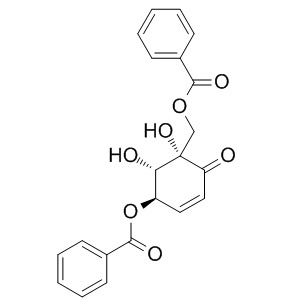Zeylenone
Zeylenone has good antitumor efficacy, it inhibits proliferation and induces apoptosis in cervical carcinoma cells via PI3K/AKT/mTOR and MAPK/ERK pathways. Zeylenone shows inhibitory activity toward the root growth of Lactuca sativa.
Inquire / Order:
manager@chemfaces.com
Technical Inquiries:
service@chemfaces.com
Tel:
+86-27-84237783
Fax:
+86-27-84254680
Address:
1 Building, No. 83, CheCheng Rd., Wuhan Economic and Technological Development Zone, Wuhan, Hubei 430056, PRC
Providing storage is as stated on the product vial and the vial is kept tightly sealed, the product can be stored for up to
24 months(2-8C).
Wherever possible, you should prepare and use solutions on the same day. However, if you need to make up stock solutions in advance, we recommend that you store the solution as aliquots in tightly sealed vials at -20C. Generally, these will be useable for up to two weeks. Before use, and prior to opening the vial we recommend that you allow your product to equilibrate to room temperature for at least 1 hour.
Need more advice on solubility, usage and handling? Please email to: service@chemfaces.com
The packaging of the product may have turned upside down during transportation, resulting in the natural compounds adhering to the neck or cap of the vial. take the vial out of its packaging and gently shake to let the compounds fall to the bottom of the vial. for liquid products, centrifuge at 200-500 RPM to gather the liquid at the bottom of the vial. try to avoid loss or contamination during handling.
Biomol Ther (Seoul).2020, 28(6):542-548.
Eur J Pharmacol.2024, 963:176280.
Journal of Functional Foods2017, 30:30-38
Phytother Res.2018, 32(5):923-932
Mol Cell.2017, 68(4):673-685
Medicina (Kaunas).2020, 56(12):685.
Plos One.2019, 15(2):e0220084
Planta Med.2019, 85(9-10):766-773
Int J Mol Sci.2023, 24(18):13713.
Molecules.2022, 27(2):451.
Related and Featured Products
J Proteomics. 2015 Aug 3;126:279-87.
Quantitative analysis of differential protein expression in cervical carcinoma cells after zeylenone treatment by stable isotope labeling with amino acids in cell culture.[Pubmed:
26130516 ]
Cervical carcinoma is a malignant tumor that poses a serious threat to women's health and survival. Approximately 10-25% of cervical cancers are adenocarcinomas (ACs). AC has high rates of recurrence and mortality, while there is no effective treatment for now. Zeylenone (Zey), which is isolated from an ethanol extract of the leaves of Uvaria grandiflora Roxb. of the family Annonaceae, has shown potent inhibitory activity against various tumor cells, including cervical carcinoma cells. To gain insight into the molecular mechanism underlying the effect of Zey on AC, we quantified protein expression changes in AC cells treated with Zey.
METHODS AND RESULTS:
We used stable isotope labeling with amino acids in cell culture (SILAC) in combination with high-performance liquid chromatography-electrospray ionization tandem mass spectrometry (HPLC-ESI-MS/MS) and bioinformatics analysis to compare protein expression profiles in HeLa cells before and after Zey treatment. Of 1805 differentially expressed proteins identified, 229 were screened as key protein molecules and classified into nine categories.
CONCLUSIONS:
Profiling of differentially-expressed proteins contributed to our understanding of the molecular mechanism by which Zey induces HeLa cell apoptosis. Using this method, candidate targets can be identified for developing new drugs against cervical carcinoma.
Sci Rep. 2017 May 10;7(1):1669.
Zeylenone, a naturally occurring cyclohexene oxide, inhibits proliferation and induces apoptosis in cervical carcinoma cells via PI3K/AKT/mTOR and MAPK/ERK pathways.[Pubmed:
28490807 ]
There is a strong rationale to therapeutically target the PI3K/Akt/mTOR and MAPK/ERK pathways in cervical carcinoma since they are highly deregulated in this disease.
Previous study by our group have demonstrated that Zeylenone (Zey) exhibited strong suppressive activity on PI3K/AKT/mTOR and MAPK/ERK signaling, providing a foundation to investigate its antitumor activity in cervical carcinoma. Herein, the present study aimed to investigate suppressive effect of Zey on HeLa and CaSki cells, and further explore the underlying mechanisms.
METHODS AND RESULTS:
Cells were treated with Zey for indicated time, followed by measuring its effects on cell viability, colony formation, cell cycle, cell apoptosis, and signal pathways. In vivo antitumor activity of Zey was then assessed with nude xenografts. We found that Zey substantially suppressed cell proliferation, induced cell cycle arrest, and increased cell apoptosis, accompanied by increased production of ROS, decreased mitochondrial membrane potential, activated caspase apoptotic cascade, and attenuated PI3K/Akt/mTOR and MAPK/ERK pathways. Additionally, in vivo experiments showed that Zey exerted good antitumor efficacy against HeLa bearing mice models via decreasing levels of p-PI3K and p-ERK.
CONCLUSIONS:
Collectively, these data clearly demonstrated the antitumor activity of Zey in cervical carcinoma cells, which is most likely via the regulation of PI3K/Akt/mTOR and MAPK/ERK pathways.
Biosci Biotechnol Biochem. 2001 Jun;65(6):1395-8.
Four polyoxygenated cyclohexenes from the Chinese tree, Uvaria purpurea.[Pubmed:
11471741 ]
METHODS AND RESULTS:
Two novel polyoxygenated cyclohexenes, 6-methoxyzeylenol (3) and 2-acetoxyZeylenone (4), together with two known compounds, zeylenol (1) and Zeylenone (2), were isolated from the heartwood of the Chinese tree, Uvaria purpurea. Zeylenol (1) and Zeylenone (2) both showed inhibitory activity toward the root growth of Lactuca sativa.
CONCLUSIONS:
Their structures were established by spectroscopic and chemical methods.



